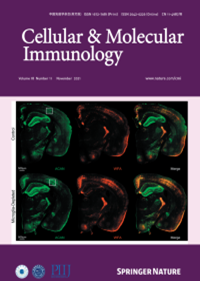肝巨噬细胞:发育、动态和功能。
IF 19.8
1区 医学
Q1 IMMUNOLOGY
引用次数: 0
摘要
肝脏是一个巨大的内脏器官,其主要功能包括营养代谢、毒素清除和能量储存。除了这些关键功能外,肝脏也是一个重要的免疫部位。它由几种特化的常驻免疫细胞组成,包括B细胞、T细胞、树突状细胞和几种巨噬细胞。它也是炎症期间急性期蛋白产生和释放的部位。在肝脏中驻扎这些免疫哨兵和效应器的一个原因是它在循环系统中的相对位置。肝脏是肠下游的第一个重要器官,来自肠的血液通过门静脉进入肝脏。这个组织促进肝脏吸收和处理直接来自肠道的营养丰富的血液。然而,肠道也是数万亿微生物的家园,其中许多是共生的,但也代表着潜在的病原体。因此,门静脉血液供应是全身性感染的途径。为了使门静脉血液消毒,肝脏免疫系统过滤病原体,这主要是由肝巨噬细胞完成的。在这里,我们将讨论居住在肝脏中的巨噬细胞的主要种群,它们的位置、功能、发育以及在肝脏面临损伤和感染时维持肝脏的作用。本文章由计算机程序翻译,如有差异,请以英文原文为准。

Liver macrophages: development, dynamics, and functions
The liver is a sizeable visceral organ whose primary functions involve nutrient metabolism, clearance of toxins, and energy storage. Besides these critical functions, the liver is also a major immunological site. It is populated by several specialized resident immune cells, including B cells, T Cells, dendritic cells, and several populations of macrophages. It is also the site for the production and release of acute-phase proteins during inflammation. One reason for garrisoning these immune sentinels and effectors in the liver is its relative location in the circulatory system. The liver is the first significant organ downstream of the intestine, where blood originating from the intestine enters the liver through the portal vein. This organization facilitates the liver’s uptake and processing of nutrient-rich blood directly from the intestinal source. However, the intestine is also home to trillions of microbes, many of which are commensals but also represent potential pathogens. As such, the portal blood supply represents an avenue for systemic infection. To sterilize the portal blood, the liver immune system filters pathogens, which is primarily accomplished by liver macrophages. Here, we will discuss the major populations of macrophages resident in the liver, their location, functions, development, and role in maintaining the liver in the face of injury and infection.
求助全文
通过发布文献求助,成功后即可免费获取论文全文。
去求助
来源期刊
CiteScore
31.20
自引率
1.20%
发文量
903
审稿时长
1 months
期刊介绍:
Cellular & Molecular Immunology, a monthly journal from the Chinese Society of Immunology and the University of Science and Technology of China, serves as a comprehensive platform covering both basic immunology research and clinical applications. The journal publishes a variety of article types, including Articles, Review Articles, Mini Reviews, and Short Communications, focusing on diverse aspects of cellular and molecular immunology.

 求助内容:
求助内容: 应助结果提醒方式:
应助结果提醒方式:


